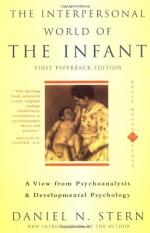
|
| Name: _________________________ | Period: ___________________ |
This quiz consists of 5 multiple choice and 5 short answer questions through Part III, Some Clinical Implications, Chapter 10, Some Implications for the Theories Behind Therapeutic Reconstructions.
Multiple Choice Questions
1. Sleep or ________ problems can also be what manifests after a person's core sense of self is dissolved for some reason.
(a) Eating.
(b) Book.
(c) Learning.
(d) Family.
2. According to the book, recent research indicates that the infant is capable of having a sense of self and ______.
(a) Body.
(b) Thoughts.
(c) Emotions.
(d) Others.
3. Regulation through the Freudian notion of the _______ is always present, according to Stern's findings.
(a) Id.
(b) Superego.
(c) Self.
(d) Ego.
4. The ________, however, needs a sense of self-coherence in order to make sense of the senses of self-agency.
(a) Adult.
(b) Researcher.
(c) Teacher.
(d) Infant.
5. Neurological and ethological viewpoints provide evidence that a sense of ______ is more sensitive during its formation.
(a) Other.
(b) Memory.
(c) Self.
(d) Knowledge.
Short Answer Questions
1. The first sense of a self created in the first 8 weeks will remain active for _______.
2. During the seventh to ninth month of development, infants are ________, but they can still create experiences that are shared.
3. Stern sees the sharing of ________ states as the most important and the most clinically observable aspect of intersubjective relatedness.
4. Stern believes the _______ to have intersubjectivity is something that must develop as a result of maturation.
5. However, other researchers have found that infants have optimum levels of __________ that they will seek and other levels they will avoid.
|
This section contains 233 words (approx. 1 page at 300 words per page) |

|




